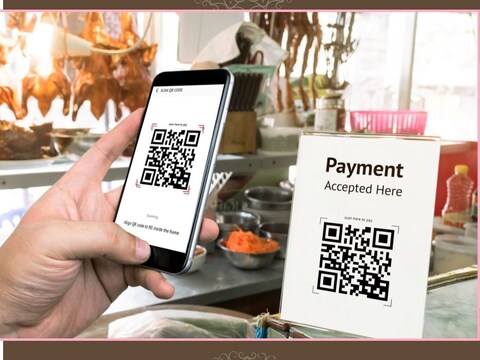The digital age has provided a lot of facilities. Online payment is a revolutionary invention of the digital age. Today most people now use payment apps and online banking to make purchases, pay bills and transfer money. Here are most important online safety tips to avoid online fraud and protect you from being scammed.
Talking about digital transactions, India is at the forefront in this online transaction. According to the report of payment system company ACI world-wide, by 2025 the use of digital transactions in India will be more than 71 percent. After the Corona period, there has been a lot of increase in digital transactions.
Ever since the facility of digital transactions started, many people have stopped carrying cash in their pockets. If they have to pay even Rs 5 at a tea shop, people instead of taking money out of their pockets, take out their mobile phones and make the payment by scanning the QR code hanging at the shop.
As the facilities provided by digital transactions have increased, new types of fraud have also increased at the same pace. Festival season is going on, obviously shopping would have increased. People are doing a lot of online shopping, most of those who are doing offline shopping are adopting the digital payment method.
As digital payment facilities are expanding, the cases of fraud are also increasing at the same pace. Here we are telling some such tips by adopting which you can protect yourself from online fraud.
What is Online fraud ?
The term “internet fraud” describes dishonest actions carried out online with the goal of stealing money or personal data from unsuspecting people. This category of cybercrime includes a broad range of tactics, such as identity theft, phishing, internet fraud, and fraudulent financial transactions.
Cybercriminals frequently utilize intricate strategies to trick individuals into disclosing private data, including credit card numbers, passwords, and social security numbers.
Phishing emails, phony websites, and dangerous software are common tactics. Because internet fraud is such a serious threat to people, companies, and financial institutions, user awareness and cybersecurity measures are crucial for defending against these online dangers.
Certain forms of online fraud aim to generate substantial financial gains by conducting a limited number of scams, whilst other forms focus on conducting numerous small-scale operations that also yield substantial financial gains.
As technology develops further, being aware and alert becomes essential to avoiding becoming a victim of the always changing world of online fraud.

6 Common Types of Online Fraud
Online fraud is a pervasive issue that comes in various forms. Here are 6 common types of online fraud:
Email Phishing Scams
Phishing is the method of pretending to be a reliable organization in order to fool people into disclosing private information, such as passwords, usernames, or bank account information. Usually, fake emails, websites, or messages are used for this.
Fraudsters employ email scams as a means of obtaining your personal information and posing a major risk to you and your companies.
Frequently, you may receive emails containing links to alluring competitions or prizes, such smartphones or the opportunity to take a trip. You will be prompted to enter certain financial or personal information, like your credit card number, after clicking on the link. In addition, a little money order might be needed to claim the prize. If you did, you will have exposed your details as swift money transfers could have been made out of your account.
Online Shopping Fraud
Online shopping fraud involves fake websites or sellers offering goods or services that don’t exist or are substandard. Victims may pay for items that are never delivered or receive counterfeit products.
Any fraud that takes place on an e-commerce platform is referred to as e-commerce fraud. Card testing fraud, account takeover fraud, friendly fraud, and other frauds are examples of e-commerce fraud.
You could become a victim of fraudulent websites that do not contain any genuine items because of the expansion of e-commerce, which has been linked to many types of electronic fraud. In other words, you will pay for something you do not receive.
Read this : how to track the location of a stolen mobile by serial number.
Payment Card Fraud
Criminals may gain access to credit or debit card information through various means, such as skimming devices, data breaches, or hacking. They then carry out illicit transactions using this information.
Skimming devices are used by thieves to obtain data from a credit card’s magnetic stripe. These devices are frequently concealed on point-of-sale terminals, petrol stations, and ATMs. Then, using the stolen information, one may generate phony cards or make purchases online.
If a physical payment card is lost or stolen, unauthorized individuals may use it to make purchases until the cardholder reports the loss to the issuing bank. Timely reporting is crucial to minimizing potential losses.
Frauds Using Mobile Devices
Installing compromised software, downloading files from unidentified sources, and clicking on specific links can all result in the theft of sensitive information like bank card numbers and passwords, as well as the compromise of personal files and images. This puts you at risk of becoming a victim of some parties who might use your data for their own gain or threaten you with financial harm.
There are occasions when someone poses as a friend of yours online using the same name and profile photo in an attempt to get personal information or a service, such a phone bill.
Computer Frauds
Certain computers, particularly those possessed by corporations and businesspeople, hold highly significant and confidential information. In this case, malicious software and links are used by hackers and scammers to compromise the computer and make it unusable. Once this happens, they contact you and demand money to unlock your personal account.
Malicious software, or malware, is designed to damage or gain unauthorized access to computer systems. This includes viruses, worms, and spyware. Ransomware is malicious software that encrypts a user’s files, rendering them inaccessible until a ransom is paid to the attacker.
Advance Fee Fraud
In advance fee fraud, scammers convince victims to pay upfront fees or charges in exchange for promised rewards, services, or financial gains that never materialize. Common examples include lottery scams or fake job offers.
The scammer may provide the victim with fraudulent documents, such as fake bank statements, legal papers, or certificates, to lend credibility to their story.
Once the victim pays the initial fee, the scammer continues to invent obstacles or unforeseen expenses, demanding additional payments. This cycle repeats until the victim realizes it’s a scam or runs out of money.
How to Safe Yourself from Online Fraud
Practical tips, such as using secure websites, implementing two-factor authentication, and regularly updating security software, can significantly enhance your online security.

Avoid scanning QR codes
QR codes are used by shopkeepers for payment. By scanning the QR code you can transfer money directly from your account to the merchant. A scammer can also use QR code to transfer money from your account to any payment app like Paytm, Grey, PhonPe etc.
Therefore, avoid scanning the QR code sent by any unknown person or third party app for any type of transaction. If you want to transfer money for an online purchase, then that person’s phone number or UPI ID type option should be adopted. With this, the entire transaction remains safe and under control.
Do not click on unknown link
now become common to withdraw all the money from the account by clicking on an unknown link. Cyber fraudsters use this technique a lot. By clicking on this type of link, all your information goes to the fraudsters.
You often receive messages on e-mails on your phone asking you to block your bank account, win the lottery or make a purchase through your ATM or credit card and then click on a link. This one click can be very harmful for you. Therefore never click on unknown links.
Clicking on such a link opens a fake website page. It is exactly like your bank page. When you upload your information on this page, hackers get your name and password and can then use it to withdraw money from your account. To avoid falling into such a scam, avoid clicking on unknown links.
If you want to get information about such messages, you can get the information by visiting your bank’s website, calling the customer care number or through mail.
Check before downloading the app
Today there are many apps for every purpose for your smartphone. Before downloading any app, complete information about it should be gathered. When downloading an app, you should see details about the app developer and see the rating of the app.
There are many instances where scammers had launched fake apps in the name of Co-Win to book appointments for the corona vaccine. Fake apps for many jobs and government schemes are available.
Install and Update Antivirus Software:
Use reputable antivirus software and keep it updated to protect against malware and other online threats. To increase the level of protection on your devices, feel free to install a trustworthy and well-known best antivirus software on your PC or smartphone.
Use Strong, Unique Passwords:
Make complicated passwords by combining special characters, numbers, and letters. Refrain from using information that can be guessed, like names or birthdays. To avoid a chain reaction in the event that one online account is compromised, use a unique password for every account.
Use Secure Websites (HTTPS)
When sharing sensitive information or making online transactions, ensure the website uses HTTPS.
Buy only from reliable websites and online retailers while making purchases online. And don’t be afraid to look into a website further to confirm its status if you have any concerns about its legitimacy. Verify that the electronic payment methods you are employing are secure.
conclusion
In conclusion, the battle against online fraud requires a collective effort. By understanding the risks, implementing preventive measures, and advocating for stronger regulations, we can create a safer digital space for everyone.


